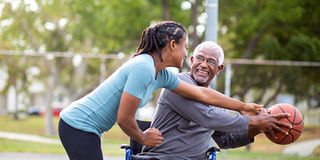Prime
You can exercise with limited mobility

What you need to know:
If you cannot get around as much as you used to due to injury, disability, illness, or weight problems, these exercises and other simple fitness tips can keep you active.
While having mobility impairment can have physical and mental effects on the person’s relationship to exercise, Quraish Golooba, a physiotherapist at Case Medical Centre in Kampala, says these people can still exercise. However, he says, while there is a need to stay healthy, even in this state, there are particular exercises each can do.
“You may have an issue with adjusting to what your body can do, more so if your injury is recent. However, you need to listen to your body, and be kind to yourself,” he says, adding that the need to exercise is not for big goals but rather to be able to stay fit with realistic and mindful targets. Therefore, before starting any exercise:
Consult
Before starting to exercise or even in the course of an exercise regimen, Veron Bikamata, a fitness expert, says one must consult a fitness professional trained to handle that particular special group. He says you need to get a trainer who specialises in helping people of your impairment and to ensure that everything is done in moderation to avoid further injury.
Warm up
Golooba says before anyone engages in any exercise, they should warm up. “Stretching helps the body to get into exercise mode and avoids shocks,” he says. Examples of warm up exercises also include cycling.
Start slow
The workout is a process, therefore, it is important that you do not out run the body. “Take baby steps as this will help you to avoid injury and will allow the body to recuperate well,” Golooba says.
Listen to your body. Golooba says the need to get back in shape causes some people to continue exercising even when they feel pain. “Pain is an indicator that something is not right and you need to stop to avoid any damage to the body,” he advises.
Make no comparisons
With a room full of able bodied people, comparing yourself to them is inevitable. However, Bikamata urges you to be comfortable in your skin and do only what you can. Golooba says one should never forget to cool down after exercising. “Stretch your body after all the flexing. Finally, finish your workout with some deep breathing and meditation.”
Interval training
Bikamata says one should engage in high intensity interval training (HIIT) which are cardiovascular exercises that alternate between short periods of intense aerobic exercises and less intense recovery periods.
“One can do these in a small space and they cause the body to utilise a lot of oxygen in a short period of time,” Bikamata speaks of the advantages of HIIT exercises. More to that, the number of calories lost in HIIT is greater than those lost during traditional aerobics.
An example of an HIIT is to face your chair and put your hands or elbows on the seat. Hold that position for as long as there is no strain. For those with joint-related issues, venturing into swimming is a good idea because it works the whole body and there is no injury worsening.
“Indulge in water aerobics because exercising in the water takes a lot of pressure off your joints,” he adds.
Strength training
For the wheelchair bound person, Golooba says strength exercises will strengthen their arm muscles and help burn more calories. “This in turn will help you lose weight or manage it while also gaining balance because you learn to easily resist any opposing force with ease,” he says.
Flexibility training
Although stretching is mainly used in warm up and cooling off, Bikamata says they are good to incorporate in your workout. “They help with flexibility. However, do not overdo and be gentle with yourself to avoid further damage,” he cautions.
While the list is not exhaustive, it helps you to know that exercise will help you recover faster or avoid other complications.




